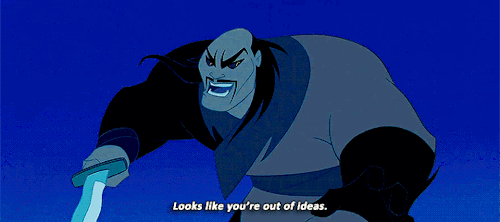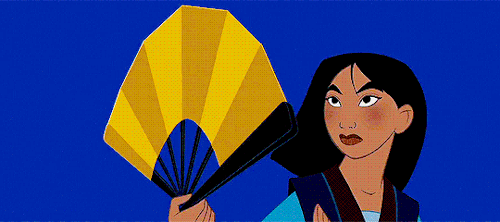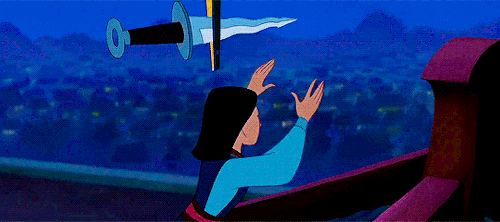ingu:marrymejasonsegel:I wrote a college paper once about gender dynamics in Disney films, and part
ingu:marrymejasonsegel:I wrote a college paper once about gender dynamics in Disney films, and part dealt with the emphasis of androgyny in this film. Mulan is an outsider and unsure of her position of the world when she is adhering to both a total feminine role (the matchmaking scene) and a total masculine role (disguised as a male soldier) and it’s only when she’s able to embrace both sides that she is able to fully showcase her abilities and ultimately save the day. The entire climax, from climbing the poles using sashes, counting on Shan Yu’s complete dismissal of women to get the Emperor to safety, to this scene where she literally uses a symbol of womanhood (within the movie at least) to disarm the villain of his symbol of masculinity and beat him at his own game, shows Mulan relying on the aspects of her femininity that she has grown up adhering to and adapting the tactical knowledge and fighting skills that she learned disguised as a male soldier to those aspects. The result is a unique and innovative view of the world and her course of action that leads her to save the day when the male soldiers failed and the women wouldn’t even have been allowed to try. This commentary is so curious to me because it’s such an excellent example of white/western cultural bias in portrayals of other cultures. Because fans by themselves are a gender neutral object in Ancient China, especially the large type that Mulan uses in this particular scene is actually masculine if you must code it historically, and in Chinese hands would be used as a tool to support her masculinity and not the other way around. These paper fans are used in general by (male) scholars and artists who decorate its surface with art and calligraphy. It is a symbol of (masculine) intellectual power and the intellectual elite. And if you look to Asian martial arts films, they are a common and almost exclusive weapon of men.Yet the movie takes this deeply cultural object and either willingly or ignorantly makes it an object of womanhood or femininity. To the extent of my knowledge, this is mostly reflective of western social history. And draws from the coquettish ways Georgian? Ladies would use the fan to signal their romantic interest and all the history and influence around it. The equivalent object for the Chinese lady would in fact be the handkerchief, or a hairstick if you want something pointy.And it’s all the more curious because at the end of the day it’s a western depiction of a foreign story made for western consumption. It is not a story made by and for Chinese little girls, but to empower and inspire those in the West. Which provides the context for the above (excellent) analysis. It does not need to fully take Chinese history into context because it was never made for us, despite being explicitly about us. -- source link


